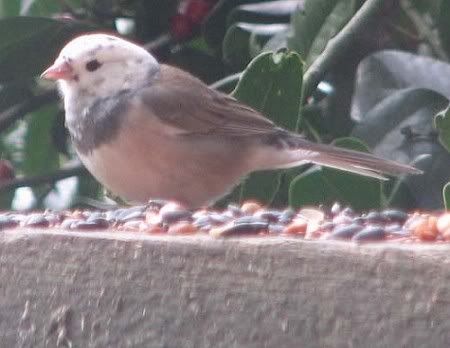Post by kastern on Apr 16, 2007 13:08:37 GMT -8
I have been discussing, both on the site and in emails to Gord, about the number of Dark Eyed Junco's I have had this year with 'albino' markings and had mentioned, to Gord, the REF numbers on my photos as given by Bird Studies Canada. Gord had asked about this.
I am a member of Bird Studies Canada - taking part in their 'Project Feederwatch' each year as well as other programs. (website is: http://www.bsc-eoc.org) When you are a member of Project Feeder Watch you are asked, besides reporting what and how many of each type of birds are at your feeder Nov. to April...to report on any rare, sick or unusual birds you see. It is reported on their website that for the 2002 - 2003 season, 249 reports were rec'd of unusual birds, with 76% of those being either albinism or partial albinism (white feathers where they shouldn't be). 9% were bill deformities and the remaining were other. Other color varients are Melanism which is extra dark plumage; xanthochroism - which is yellow or orange where they should be red (excluding variations due to diet); and erythrism which is reddish plumage.
When you send in a report of an unusually marked bird, they provide a reference number. All information is collected and passed on to biologists that are studying these variations to plumage as no one really knows why they are happening. For example re bill deformities...as of 2002-2003 season, 1300 Chickadees with bill deformities were reported in Alaska, since 1987 only 10 had been reported in the rest of the US ....leading one to believe the cause, what ever it may be, lay somewhere in Alaska.
Anyone who sees an unusually marked bird can send photos of it to Bird Studies Canada....give as much detail as you can, where, when, sex of the bird if known, how many 'normal' were around at the same time, etc. Email address is: BirdstudiesCanada@bsc.eoc.org
Kathy
I am a member of Bird Studies Canada - taking part in their 'Project Feederwatch' each year as well as other programs. (website is: http://www.bsc-eoc.org) When you are a member of Project Feeder Watch you are asked, besides reporting what and how many of each type of birds are at your feeder Nov. to April...to report on any rare, sick or unusual birds you see. It is reported on their website that for the 2002 - 2003 season, 249 reports were rec'd of unusual birds, with 76% of those being either albinism or partial albinism (white feathers where they shouldn't be). 9% were bill deformities and the remaining were other. Other color varients are Melanism which is extra dark plumage; xanthochroism - which is yellow or orange where they should be red (excluding variations due to diet); and erythrism which is reddish plumage.
When you send in a report of an unusually marked bird, they provide a reference number. All information is collected and passed on to biologists that are studying these variations to plumage as no one really knows why they are happening. For example re bill deformities...as of 2002-2003 season, 1300 Chickadees with bill deformities were reported in Alaska, since 1987 only 10 had been reported in the rest of the US ....leading one to believe the cause, what ever it may be, lay somewhere in Alaska.
Anyone who sees an unusually marked bird can send photos of it to Bird Studies Canada....give as much detail as you can, where, when, sex of the bird if known, how many 'normal' were around at the same time, etc. Email address is: BirdstudiesCanada@bsc.eoc.org
Kathy


